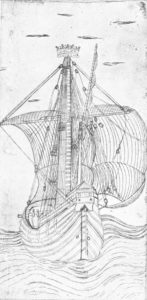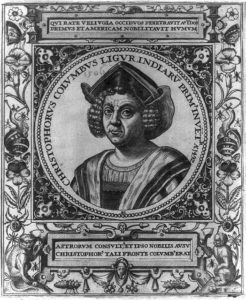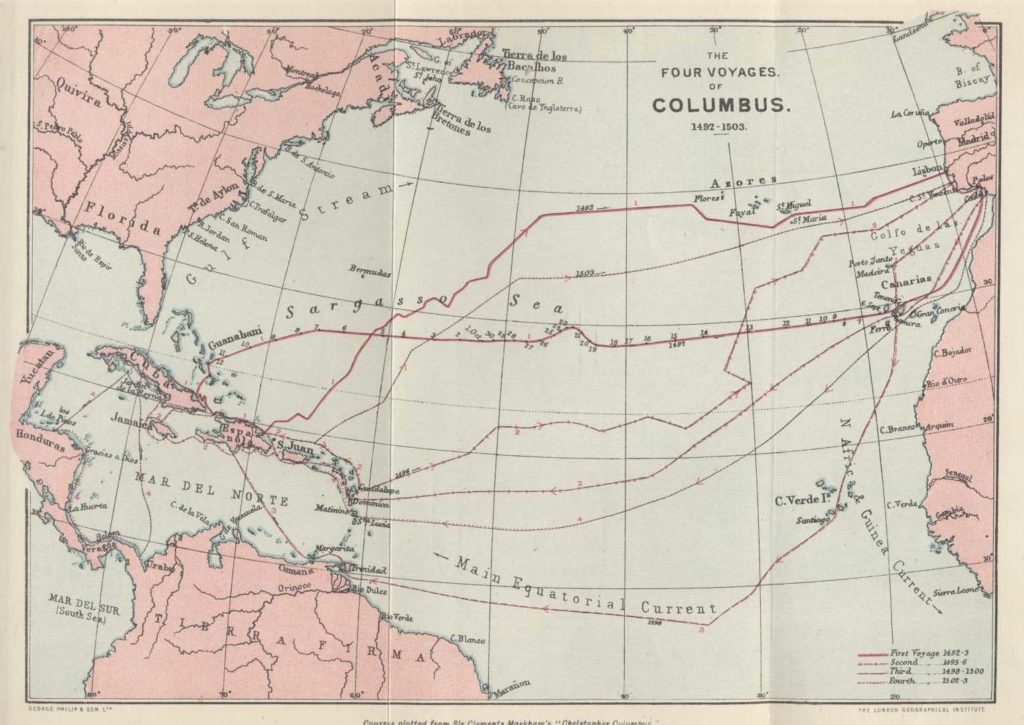Apparently in 1492 most educated Europeans knew that the earth was spherical. The Atlantic Ocean was beginning to be explored; the technology of the mariner’s compass made it easier to figure out which way you were going, and “a certain Genoese mariner” was inspired by a book to sail west.
From A Short History of the World by H.G. Wells
The publication of Marco Polo’s travels produced a profound effect upon the European imagination. The European literature, and especially the European romance of the fifteenth century, echoes with the names in Marco Polo’s story, with Cathay (North China) and Cambulac (Pekin) and the like.
Two centuries later, among the readers of the Travels of Marco Polo was a certain Genoese mariner, Christopher Columbus, who conceived the brilliant idea of sailing westward round the world to China. In Seville there is a copy of the Travels with marginal notes by Columbus. There were many reasons why the thought of a Genoese should be turned in this direction. Until its capture by the Turks in 1453 Constantinople had been an impartial trading mart between the Western world and the East, and the Genoese had traded there freely. But the “Latin” Venetians, the bitter rivals of the Genoese, had been the allies and helpers of the Turks against the Greeks, and with the coming of the Turks Constantinople turned an unfriendly face upon Genoese trade. The long forgotten discovery that the world was round had gradually resumed its sway over men’s minds. The idea of going westward to China was therefore a fairly obvious one. It was encouraged by two things. The mariner’s compass had now been invented and men were no longer left to the mercy of a fine night and the stars to determine the direction in which they were sailing, and the Normans, Catalonians and Genoese and Portuguese had already pushed out into the Atlantic as far as the Canary Isles, Madeira and the Azores.
![Atlantic_Ocean,_Toscanelli,_1474 (By Bartholomew, J. G. - A literary and historical atlas of America, by Bartholomew, J. G. [1], Public Domain, https://commons.wikimedia.org/w/index.php?curid=8304706; https://en.wikipedia.org/wiki/Christopher_Columbus#/media/File:Atlantic_Ocean,_Toscanelli,_1474.jpg)](https://www.bluegrayreview.com/wp-content/uploads/2018/10/1200px-Atlantic_Ocean_Toscanelli_1474-300x183.jpg)
“Toscanelli’s notions of the geography of the Atlantic Ocean (shown superimposed on a modern map), which directly influenced Columbus’s plans.”
The success of Columbus stimulated overseas enterprise enormously. In 1497 the Portuguese sailed round Africa to India, and in 1515 there were Portuguese ships in Java. In 1519 Magellan, a Portuguese sailor in Spanish employment, sailed out of Seville westward with five ships, of which one, the Vittoria, came back up the river to Seville in 1522, the first ship that had ever circumnavigated the world. Thirty-one men were aboard her, survivors of two-hundred-and- eighty who had started. Magellan himself had been killed in the Philippine Isles.
Printed paper books, a new realization of the round world as a thing altogether attainable, a new vision of strange lands, strange animals and plants, strange manners and customs, discoveries overseas and in the skies and in the ways and materials of life burst upon the European mind. The Greek classics, buried and forgotten for so long, were speedily being printed and studied, and were colouring men’s thoughts with the dreams of Plato and the traditions of an age of republican freedom and dignity. The Roman dominion had first brought law and order to Western Europe, and the Latin Church had restored it; but under both Pagan and Catholic Rome curiosity and innovation were subordinate to and restrained by organization. The reign of the Latin mind was now drawing to an end. Between the thirteenth and the sixteenth century the European Aryans, thanks to the stimulating influence of Semite and Mongol and the rediscovery of the Greek classics, broke away from the Latin tradition and rose again to the intellectual and material leadership of mankind.



